
“Toyota's first mass-market EV is nice to drive, but not nice to live with.”
- Composed driving dynamics
- Available all-wheel drive
- Bizarre styling
- Poor ergonomics
- Frustrating infotainment system
Toyota may have been a pioneer with hybrids, but Japan’s largest automaker has been slower to adopt electric vehicles. Now, with forecasts of stricter emissions standards in places like California and Europe, and many rivals launching their own EVs, Toyota is finally seeing the writing on the wall.
The 2023 Toyota bZ4X represents a new era for the automaker. It’s what Toyota claims will be the first of many mass-market EVs under its new “bZ” line, which is short for “beyond zero.” It’s a departure not only from capitalization norms, but also Toyota’s previous focus on hybrids and hydrogen fuel-cell vehicles, which the automaker has long pitched as alternatives to battery-powered cars.
Like most of its rivals, Toyota decided its first mass-market EV should be a compact crossover SUV, a sensible move given the current popularity of these vehicles. The bZ4X is available in single-motor front-wheel drive and dual-motor all-wheel drive configurations and XLE or Limited trim levels. Pricing starts at $43,215, but runs to $49,995 (before options) for an all-wheel drive Limited model like our test car, which had a few options that pushed the as-tested price up to $52,468.
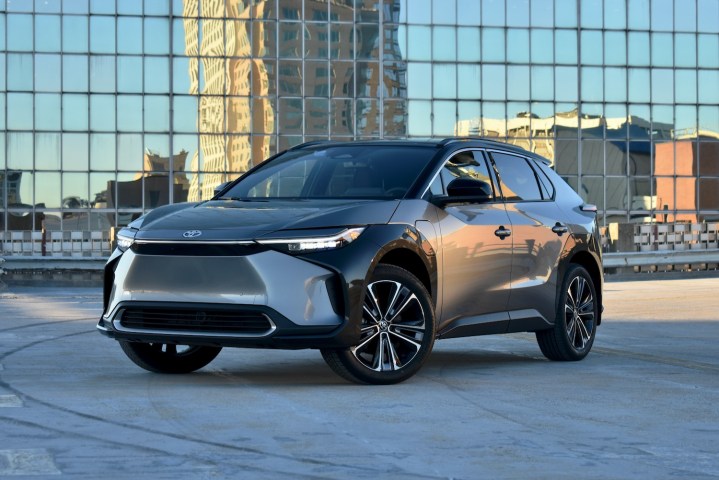
Design and interior
Much like the Ford Mustang Mach-E and Volkswagen ID.4, the bZ4X looks more like a tall hatchback or wagon than a proper SUV. The blacked-out panels around the wheel wells seem like they were intended to reference SUV body cladding, but just look misshapen in person. The bZ4X does at least vaguely resemble the popular Toyota RAV4 crossover in profile view, thanks to its upright roof and faceted surfaces, but the sagging, grille-less front fascia makes this EV look like it needs antidepressants. That impression isn’t helped by the running-eyeliner trim around the taillights.
It may look unusual, but this Toyota EV’s bones are not unique. Other automakers have developed dedicated vehicle architectures for their electric cars, but Toyota opted to repurpose its Toyota New Global Architecture (TNGA) for the bZ4X, dubbing the EV version e-TNGA. Subaru also helped with development, expanding an existing partnership between the two automakers, and will sell a nearly identical version of the bZ4X as the Solterra. Toyota’s Lexus luxury brand will get its own version as well, called the RZ 450e.
The bZ4X is longer and lower than the RAV4, but this doesn’t translate to a noteworthy amount of interior space. The bZ4X has less headroom than other EVs in its price range, and substantially less front legroom than the Mach-E and the smaller Chevrolet Bolt EUV. Rear-seat legroom is back-of-the-pack, although the back seats felt more spacious than they appear on paper.
The interior is certainly different, but not necessarily attractive.
The bZ4X does offer a competitive amount of cargo space, but lacks a frunk. Front storage isn’t a given among non-Tesla EVs, admittedly. The back seats also work surprisingly well as a storage space, thanks to a relatively flat floor that makes it easy to slide items from one side to the other for curbside unloading.
Like the exterior, the interior is certainly different, but not necessarily attractive. The array of black and gray plastics and fabrics feel like a throwback to 1980s car interiors, but the shiny, smudge-prone piano black trim is frustratingly current. The dashboard also has a rounded shape that highlights the infotainment touchscreen and instrument cluster, while the center console rises up to give the interior a more enclosed, cockpit-like feel.
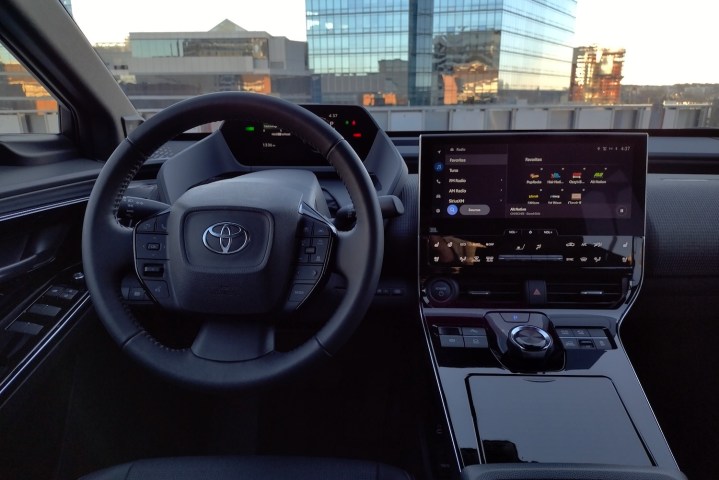
This layout led to some unusual ergonomic choices. Toyota didn’t include a glovebox, so instead, the owner’s manual, registration, and other things you would normally keep there live in a secret compartment in the center console where they’re likely to be forgotten. The console’s height would likely make a conventional shift lever impractical, so instead, you twist a knob to engage drive or reverse. That raised console also makes room for a helpful floor-level storage nook like the one in the Toyota Sienna minivan, at least, and puts controls within easy reach.
Tech, infotainment, and driver assist
At first glance, Toyota seems to have covered the bases when it comes to tech. A 7.0-inch digital instrument cluster is standard, along with a 12.3-inch touchscreen infotainment system that includes wireless Apple CarPlay and Android Auto connectivity, natural language voice recognition, and over-the-air update capability. A Wi-Fi hotspot (with service provided by AT&T) and a nine-speaker JBL audio system are available as well.
However, the interface isn’t that nice to use. While we were impressed that the freestanding instrument cluster didn’t wash out in direct sunlight, some drivers will find that the steering wheel blocks the lower half. This isn’t a problem in other markets, where Toyota equips the bZ4X with a steering yoke that looks a bit like an oversized video game controller, rather than a conventional wheel.
Toyota has done a good job of making its infotainment systems easy to use, if not exciting, but here the array of small touchscreen icons blend with the similarly sized buttons below for an unattractive and confusing morass. The screen itself was also slow to boot up when starting the car, and while the notification for incoming text messages was panic-inducingly loud, the actual message playback was too faint to hear.
Screen icons and buttons blend into an unattractive and confusing morass.
The bZ4X comes standard with four USB-C charging ports — two for each row of seats — and a USB-A port for media input. Wireless phone charging is included as well, and Toyota put the charging pad beneath an opaque cover so you won’t be tempted to look at your phone. With the bZ4X, Toyota also becomes the latest automaker to offer digital key functionality, allowing users of certain smartphones to ditch the key fob and use their phones to lock, unlock, and drive their cars.
The bZ4X is also the first model to get the latest Toyota Safety Sense 3.0 system, which features improved radar and camera performance, according to Toyota. The list of standard driver-assist features enabled by these sensors includes forward collision warning, automatic emergency braking, blind spot monitoring, rear cross-traffic alert, lane keep assist, lane tracing assist automated lane centering, and safe exit assist, which uses the blind spot sensors to warn of oncoming traffic while getting out of the car. A 360-degree camera system is also available on the Limited trim level.
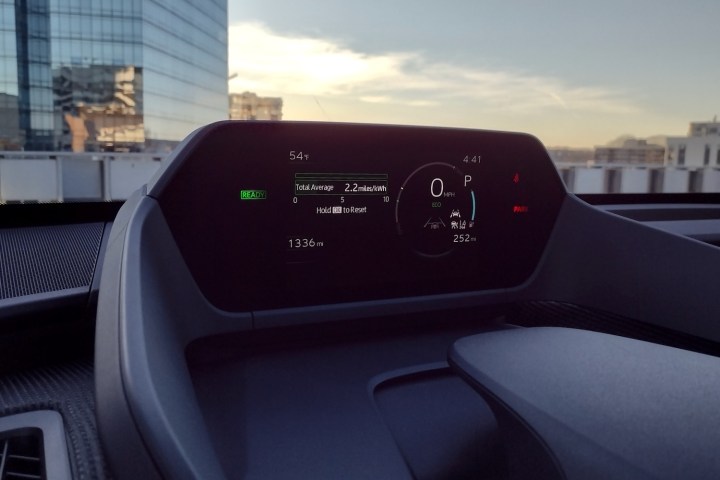
EVs tend to be where automakers show off their most advanced driver assist features, or in some cases demonstrate a lack of advancement in that area. Toyota falls into the latter category. While the Ford Mustang Mach-E offers the hands-free BlueCruise system, the Nissan Ariya can execute automated lane changes with its ProPilot Assist 2.0 system, and even the humble Chevy Bolt EUV can be equipped with General Motors’ Super Cruise hands-free system, Toyota only offers hands-on adaptive cruise with the aforementioned lane tracing assist feature to keep the car in its lane.
Driving experience
Front-wheel drive bZ4X models are powered by a single electric motor producing 201 horsepower and 196 pound-feet of torque, fed by a 71.4-kilowatt-hour battery pack. All-wheel drive models get two motors, one powering each axle, but that only ups total output to 214 hp and 248 lb.-ft. of torque. Battery capacity increases to 72.8 kWh.
Toyota says front-wheel drive versions will do zero to 60 mph in 7.1 seconds, while all-wheel drive models cut that down to 6.5 seconds. Neither is exactly quick by modern standards, and Toyota hasn’t discussed plans for a performance version comparable to the Kia EV6 GT or Ford Mustang Mach-E GT, but this is more than adequate acceleration for everyday driving.
Toyota gave the bZ4X a planted, composed feel that rivals can’t match.
The bZ4X is resolutely mundane in the handling department as well, but while it doesn’t offer the sportiness of some EVs, it does at least work well as a daily driver. It won’t play along if you try to hustle it, but we still found the precise feel of the steering and the ride quality enjoyable. Toyota gave the bZ4X a planted, composed feel that rivals like the Hyundai Ioniq 5 and Volkswagen ID.4 can’t match.
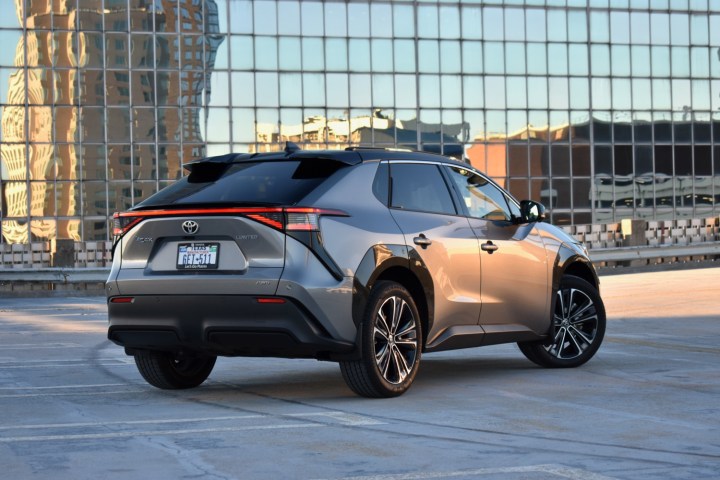
Because the bZ4X was co-developed with Subaru, all-wheel drive versions also get that automaker’s X-Mode, which includes Snow/Dirt and Snow/Mud drive modes for slippery surfaces. Hill descent control is included as well, and the bZ4X boasts a respectable 8.1 inches of ground clearance. That means the Toyota should be able to handle dirt roads and deep snow comfortably, but because it lacks a high degree of suspension articulation and more precise traction controls beyond the two X-Mode drive modes, we wouldn’t call it a true off-roader.
Range, charging, and safety
The bZ4X has a maximum range of 252 miles in base XLE front-wheel drive form. That drops to 242 miles for the Limited grade. All-wheel drive comes with an even bigger range penalty, with ratings of 228 miles and 222 miles for XLE and Limited trim levels, respectively.
Toyota includes standard DC fast charging, and the bZ4X’s Combined Charging Standard (CCS) connector means finding a compatible station shouldn’t be difficult. With maximum power rates of 150 kilowatts for front-wheel drive models and 100 kW for all-wheel drive models, Toyota claims an 80% charge is possible in 30 minutes, but we found that’s very dependent on ambient temperature. If you’ve got a 240-volt Level 2 AC charging station at home, you’re looking at 9.5 hours for a full recharge with the bZ4X’s 6.6-kW onboard charger, according to Toyota.
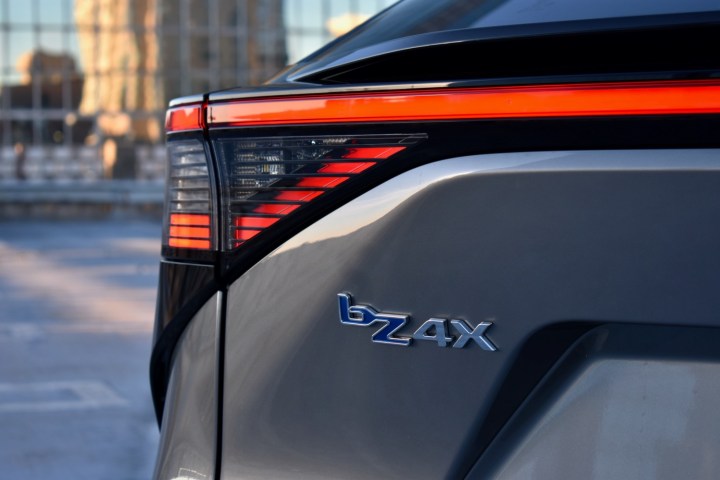
The bZ4X gets the same three-year, 36,000-mile basic warranty and five-year, 60,000-mile powertrain warranty as Toyota’s gasoline cars, as well as an eight-year, 100,000-mile,warranty covering the battery pack and other related components. The battery warranty is competitive with other EVs, but we can’t make a comparison on safety because the Insurance Institute for Highway Safety (IIHS) and National Highway Traffic Safety Administration (NHTSA) haven’t published crash test ratings for the bZ4X yet.
How DT would configure this car
Toyota may market the bZ4X as a rugged SUV, but the version that makes the most sense to get is the base front-wheel drive XLE. It’s the least expensive, has the most range, and even boasts more powerful DC fast charging than all-wheel drive models. The added traction of all-wheel drive might be worthwhile depending on where you live, but the relatively small increases in horsepower and torque definitely aren’t. The XLE also includes nearly all available tech features; the Limited only adds digital key integration, the 360-degree camera system, and the option for the JBL audio system upgrade.
The bZ4X is a competent EV, but most of the things that set it apart, like the unorthodox exterior styling and interior layout, are more gimmicky than useful. The similarly sized Hyundai Ioniq 5 also offers distinctive styling that is, in our opinion, more attractive. It also undercuts the Toyota in price, and while the base SE Standard Range model only has 220 miles of range, its 350-kW DC fas- charging capability means road trip charging will be less of an issue.
If all you want is basic zero-emission transportation, the Chevy Bolt EUV, Hyundai Kona Electric, and Kia Niro EV offer 247 miles, 258 miles, and 253 miles of range, respectively, for less than the base bZ4X XLE. The Bolt EUV is also available with General Motors’ game-changing Super Cruise driver-assist system and, unlike the Toyota, is expected to qualify for a $7,500 federal tax credit. These EVs are all smaller than the bZ4X, however, which is most apparent in cargo space.
Considering how late it is to the EV party, and how ambivalent management has been about EVs up to this point, it was unlikely that Toyota would raise the bar with the bZ4X. But Toyota’s first serious attempt at an EV is better than expected.



